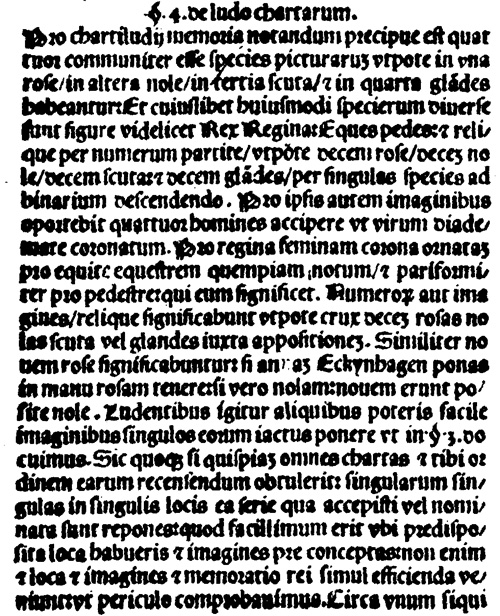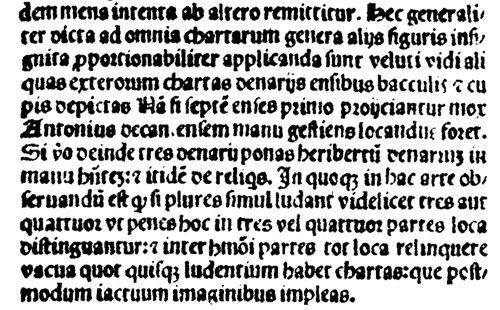DoctorArcanus
In the digital collection of the Warburg Institute, I have found a 1562 “Art of Memory” book by Lodovico Dolce. In 1540, Dolce wrote the tercets for the Marcolini card divination book.
The title of the book is “Dialogo di M. Lodovico Dolce nel quale si ragiona del modo di accrescere e conservr a memoria” (Dialogue by Lodovico Dolce in which it is reasoned about the way to increase and preserve memory). It was published in Venice.
The book includes illustrations from older German books on the same argument. According to this book, Dolce is actually translating a Latin dialogue by Johannes Romberch (1520).
At the end of the book (pag. 117) there is a paragraph in which the author explains how to apply memory techniques to card games. There is nothing particularly surprising in this text, but I give here a translation in case someone is interested:
In order to use memory in card games, the first thing you must consider is that in cards there are four types of figures. For instance we can call the first coins, the second swords, the third wands and the fourth cups. Each of them has his King, Horse and Knave. For this figures you will image four men, that represent these four figures [the suits] with their own devices. The images of numbers will represent the rest: for instance the cross [see the table at page 36] will represent the ten of swords, the ten of coins, the ten of wands and the ten of cups. The same for the other numbers. When people play, you will be able to store the points of each one, with the method described above. And if someone will ask you to tell the cards they played and in which order, you will put each point and each of them in as many places, in the order in which they were taken. This will be easy for you, if you had prepared the places in advance and invented the images. Because you cannot create the images and the places and memorize at the same time: because, when the mind is busy at one thing, it loses the others. And this can be enough for all cards, that are different in the different nations. If three or four people will play, the places must be divided in three or four parts: and in these parts there must be as many empty places as the cards that each player holds in his hand. You will fill these places with images as soon as the cards are played.
As explained by Frances Yates, ancient memory techniques required to imagine "places" in which to store "images" corresponding to the things to be remembered.
It would be interesting to know if the passage about playing cards is in Romberch too (I guess so).
The title of the book is “Dialogo di M. Lodovico Dolce nel quale si ragiona del modo di accrescere e conservr a memoria” (Dialogue by Lodovico Dolce in which it is reasoned about the way to increase and preserve memory). It was published in Venice.
The book includes illustrations from older German books on the same argument. According to this book, Dolce is actually translating a Latin dialogue by Johannes Romberch (1520).
At the end of the book (pag. 117) there is a paragraph in which the author explains how to apply memory techniques to card games. There is nothing particularly surprising in this text, but I give here a translation in case someone is interested:
In order to use memory in card games, the first thing you must consider is that in cards there are four types of figures. For instance we can call the first coins, the second swords, the third wands and the fourth cups. Each of them has his King, Horse and Knave. For this figures you will image four men, that represent these four figures [the suits] with their own devices. The images of numbers will represent the rest: for instance the cross [see the table at page 36] will represent the ten of swords, the ten of coins, the ten of wands and the ten of cups. The same for the other numbers. When people play, you will be able to store the points of each one, with the method described above. And if someone will ask you to tell the cards they played and in which order, you will put each point and each of them in as many places, in the order in which they were taken. This will be easy for you, if you had prepared the places in advance and invented the images. Because you cannot create the images and the places and memorize at the same time: because, when the mind is busy at one thing, it loses the others. And this can be enough for all cards, that are different in the different nations. If three or four people will play, the places must be divided in three or four parts: and in these parts there must be as many empty places as the cards that each player holds in his hand. You will fill these places with images as soon as the cards are played.
As explained by Frances Yates, ancient memory techniques required to imagine "places" in which to store "images" corresponding to the things to be remembered.
It would be interesting to know if the passage about playing cards is in Romberch too (I guess so).



